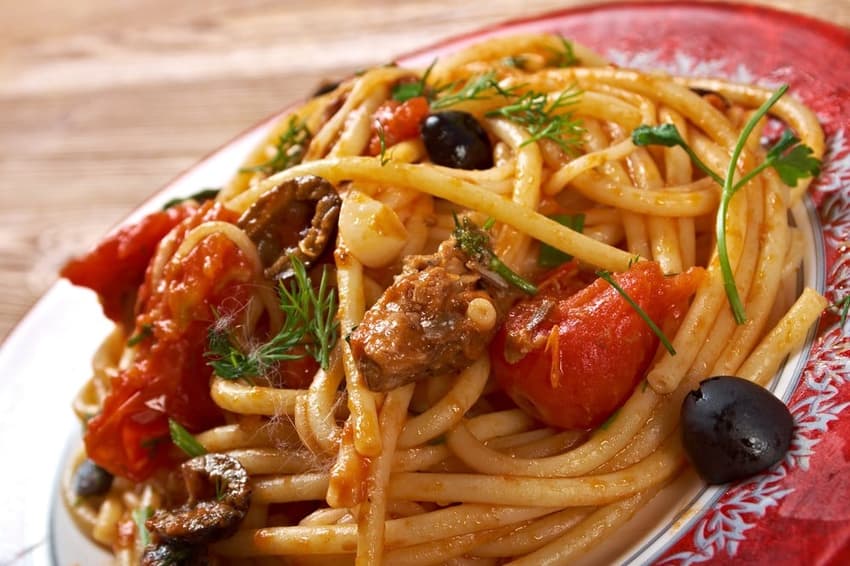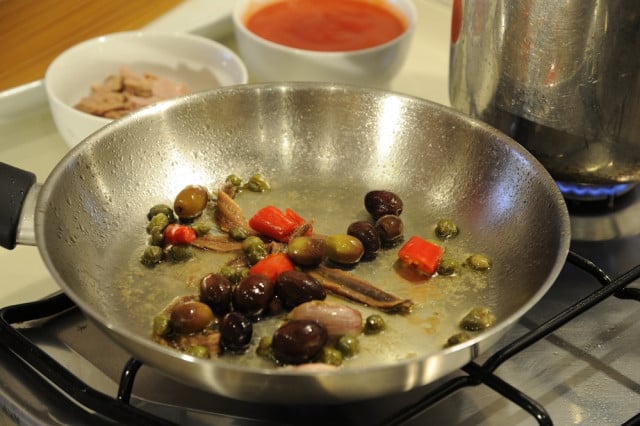How to make the classic pasta alla puttanesca

Quick and easy to make, this flavourful pasta sauce with unconventional origins is a staple in Italian kitchens everywhere. Food writer Silvana Lanzetta explains how to get it right.
Puttanesca sauce is one of the pillars of traditional Italian cuisine, with two cities that claim to be its birthplace: Rome and Naples. The difference between the two recipes is that the Roman version contains anchovies, whereas in Naples we don’t use them. We just call it pasta aulive e cchjapparielle, which is Neapolitan for olives and capers.
With or without anchovies, puttanesca sauce is very simple to make and extremely tasty. The main ingredients are garlic,olives (Gaeta or any juicy black olives, such as Kalamata), capers, chilli, and tomato sauce.
The origins of the recipe date back to the XIX century, and the name indicates that it was first created in a red light district to feed the workers and their customers.
In his book “Naples at the table”, the food critic Arthur Schwartz tells us that the origins of the puttanesca sauce are to be located at the beginning of the XX century in Naples, in the Spanish Quarter, where there used to be a certain number of “pleasure houses.”
Despite its unconventional origins, puttanesca sauce is a staple at all Italian tables, and for a very good reason: it’s easy and quick to make, and it tastes delicious.
It doesn’t matter whether you prefer the Roman version with anchovies or the vegan Neapolitan version (I prefer it with anchovies, and I am Neapolitan!), just try it and I am sure it will very soon become one of your favourite family dinners.
Ingredients
-
360cgr of spaghetti, bucatini, or penne
-
1 can of chopped tomatoes
-
2 garlic cloves, finely chopped
-
100 gr of black olives (Gaeta or Kalamata)
-
50 gr of capers
-
4 anchovy fillets (optional)
-
2 tbsp of extra-virgin olive oil
-
1 tiny pinch of crushed chilli
-
Salt to taste

You'll need a deep non-stick frying pan for this recipe. Photo: Depositphotos
Instructions:
Step 1
To make a delicious puttanesca sauce, start by slowly heating the oil, the crushed garlic and the chilli in a deep non-stick pan. After about five minutes add the anchovy fillets, if using, and cook until they melt.
Step 2
Stir in the capers and olives, and cook on medium heat for another five minutes, stirring occasionally.
Step 3
Add the canned tomato, raise the heat and bring to the boil. Reduce the heat as soon as the sauce starts to bubble, and simmer it for 10-15 minutes. Salt to taste.
Step 4
Meanwhile, in a large pot, bring salted water to the boil. Cook the pasta of your choice according to the pack instructions. When cooked, before draining it, save a ladleful of the pasta cooking water.
Step 5
Drain the pasta and tip it in the pot with the sauce. Add the ladleful of cooking water, and sauté for a couple of minutes, until the water has evaporated. Serve immediately.
TRY ALSO:
-
Spinach frittata, a true Italian classic
-
Bake your own rosemary focaccia
-
Strawberry and limoncello tiramisù
Recipe tips:
Traditionally puttanesca sauce is served without grated cheese, as the strong flavours of the capers and olives clash with it.
To make your sauce even tastier, start to flavour the oil a couple of hours before serving the pasta. Follow the recipe until step 2, then take the pan off the heat, cover, and set aside. By allowing it to rest for a couple of hours, the oil will absorb all the flavours from the garlic, anchovies, and capers, resulting in an amazingly flavourful sauce.

Silvana Lanzetta. Photo: Private
Silvana Lanzetta was born into a family of pasta makers from Naples and spent 17 years as a part-time apprentice in her grandmother’s pasta factory. She specializes in making pasta entirely by hand and runs regular classes and workshops in London.
Find out more at her website, Pastartist.com, including this recipe and others.
Comments
See Also
Puttanesca sauce is one of the pillars of traditional Italian cuisine, with two cities that claim to be its birthplace: Rome and Naples. The difference between the two recipes is that the Roman version contains anchovies, whereas in Naples we don’t use them. We just call it pasta aulive e cchjapparielle, which is Neapolitan for olives and capers.
With or without anchovies, puttanesca sauce is very simple to make and extremely tasty. The main ingredients are garlic,olives (Gaeta or any juicy black olives, such as Kalamata), capers, chilli, and tomato sauce.
The origins of the recipe date back to the XIX century, and the name indicates that it was first created in a red light district to feed the workers and their customers.
In his book “Naples at the table”, the food critic Arthur Schwartz tells us that the origins of the puttanesca sauce are to be located at the beginning of the XX century in Naples, in the Spanish Quarter, where there used to be a certain number of “pleasure houses.”
Despite its unconventional origins, puttanesca sauce is a staple at all Italian tables, and for a very good reason: it’s easy and quick to make, and it tastes delicious.
It doesn’t matter whether you prefer the Roman version with anchovies or the vegan Neapolitan version (I prefer it with anchovies, and I am Neapolitan!), just try it and I am sure it will very soon become one of your favourite family dinners.
Ingredients
-
360cgr of spaghetti, bucatini, or penne
-
1 can of chopped tomatoes
-
2 garlic cloves, finely chopped
-
100 gr of black olives (Gaeta or Kalamata)
-
50 gr of capers
-
4 anchovy fillets (optional)
-
2 tbsp of extra-virgin olive oil
-
1 tiny pinch of crushed chilli
-
Salt to taste

You'll need a deep non-stick frying pan for this recipe. Photo: Depositphotos
Instructions:
Step 1
To make a delicious puttanesca sauce, start by slowly heating the oil, the crushed garlic and the chilli in a deep non-stick pan. After about five minutes add the anchovy fillets, if using, and cook until they melt.
Step 2
Stir in the capers and olives, and cook on medium heat for another five minutes, stirring occasionally.
Step 3
Add the canned tomato, raise the heat and bring to the boil. Reduce the heat as soon as the sauce starts to bubble, and simmer it for 10-15 minutes. Salt to taste.
Step 4
Meanwhile, in a large pot, bring salted water to the boil. Cook the pasta of your choice according to the pack instructions. When cooked, before draining it, save a ladleful of the pasta cooking water.
Step 5
Drain the pasta and tip it in the pot with the sauce. Add the ladleful of cooking water, and sauté for a couple of minutes, until the water has evaporated. Serve immediately.
TRY ALSO:
- Spinach frittata, a true Italian classic
- Bake your own rosemary focaccia
- Strawberry and limoncello tiramisù
Recipe tips:
Traditionally puttanesca sauce is served without grated cheese, as the strong flavours of the capers and olives clash with it.
To make your sauce even tastier, start to flavour the oil a couple of hours before serving the pasta. Follow the recipe until step 2, then take the pan off the heat, cover, and set aside. By allowing it to rest for a couple of hours, the oil will absorb all the flavours from the garlic, anchovies, and capers, resulting in an amazingly flavourful sauce.

Silvana Lanzetta. Photo: Private
Silvana Lanzetta was born into a family of pasta makers from Naples and spent 17 years as a part-time apprentice in her grandmother’s pasta factory. She specializes in making pasta entirely by hand and runs regular classes and workshops in London.
Find out more at her website, Pastartist.com, including this recipe and others.
Join the conversation in our comments section below. Share your own views and experience and if you have a question or suggestion for our journalists then email us at [email protected].
Please keep comments civil, constructive and on topic – and make sure to read our terms of use before getting involved.
Please log in here to leave a comment.